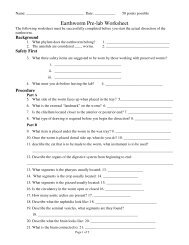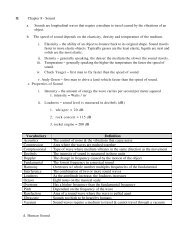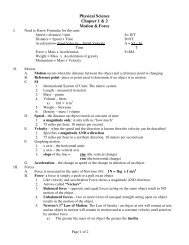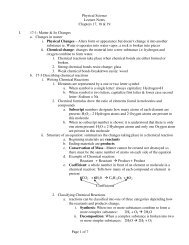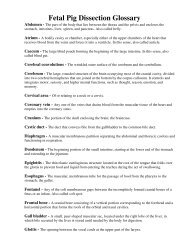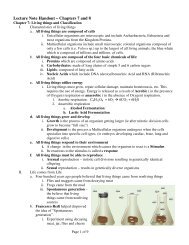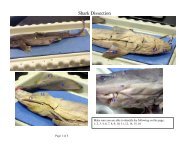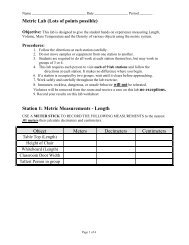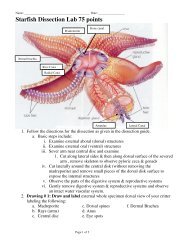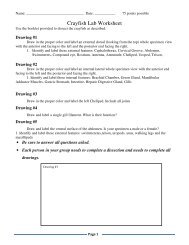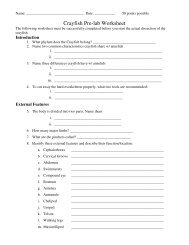Chapter 2 Minerals and Rocks ⢠Section 1 Summary - Mr.E Science
Chapter 2 Minerals and Rocks ⢠Section 1 Summary - Mr.E Science
Chapter 2 Minerals and Rocks ⢠Section 1 Summary - Mr.E Science
Create successful ePaper yourself
Turn your PDF publications into a flip-book with our unique Google optimized e-Paper software.
Lecture Notes<br />
Earth <strong>Science</strong><br />
<strong>Chapter</strong> 2<br />
<strong>Minerals</strong> <strong>and</strong> <strong>Rocks</strong> • <strong>Section</strong> 1 <strong>Summary</strong><br />
Key Concepts<br />
■ What is a mineral<br />
■ What are the three major groups of rock, <strong>and</strong> how do they form through the rock cycle<br />
■ How are minerals <strong>and</strong> rocks used <strong>and</strong> processed<br />
A mineral is a naturally occurring, inorganic solid that forms on or beneath Earth's surface. Almost<br />
all minerals have a crystal shape. Each mineral has a definite chemical composition. More than 3,000<br />
minerals have been identified.<br />
<strong>Rocks</strong> are made up of a combination of minerals. Geologists classify rocks into three major groups:<br />
igneous rock, sedimentary rock, <strong>and</strong> metamorphic rock. The rocks in each group form through<br />
different steps in the rock cycle.<br />
Igneous rocks form from molten material deep inside Earth. The material slowly cools <strong>and</strong> hardens to<br />
form a rock. If the material cools slowly, large crystals form. If the material cools quickly, small crystals<br />
form.<br />
Sedimentary rocks are made from pieces of rocks that have been broken down by processes involving<br />
water <strong>and</strong> weather. The pieces are called sediment. Sediment can also contain remains of plants <strong>and</strong><br />
animals. The sediment gets moved by water <strong>and</strong> wind <strong>and</strong> gets deposited in layers. Over millions of years,<br />
the sediments are squeezed together <strong>and</strong> become sedimentary rock.<br />
Metamorphic rocks form when rocks are exposed to a great increase in temperature <strong>and</strong> pressure. This<br />
occurs deep within Earth's interior where it is hotter <strong>and</strong> the overlying rock cause great pressure. <strong>Minerals</strong><br />
may get changed to other minerals forming a new rock. Mineral grains also become aligned in response to<br />
the increased pressure. If the heat <strong>and</strong> pressure become too great, the rock melts <strong>and</strong> the rock cycle begins<br />
again.<br />
<strong>Minerals</strong> are the source of gemstones, metals, <strong>and</strong> other materials used to make many products.<br />
Gemstones are hard, colorful minerals that are used not only for jewelry but also for cutting, grinding <strong>and</strong><br />
polishing. <strong>Minerals</strong> are used in foods, medicine, fertilizer, <strong>and</strong> building materials. <strong>Minerals</strong> are also the<br />
source of metals such as copper, iron, <strong>and</strong> silver.<br />
Today, people use rocks for building materials <strong>and</strong> in industrial processes. A rock that contains a<br />
metal or mineral that can be mined <strong>and</strong> sold for a profit is called an ore. To produce metal from ore, the ore<br />
must be mined, or removed from the ground. Then the ore must be processed to extract the metal.<br />
Mining is done in one of three ways. Strip mining removes the overlying layers of soil <strong>and</strong> rock to reveal the<br />
ore beneath. Open pit mining involves digging a huge pit to get to the ore. Shaft mining is used when the ore<br />
occurs in veins far beneath the surface.<br />
The mined ore must be processed before it can be used. During smelting, the ore is mixed with other<br />
substances <strong>and</strong> then melted. The useful ore separates from the rest of the rock. The pure ore is removed.<br />
<strong>Rocks</strong> <strong>and</strong> Weathering ■ <strong>Section</strong> 2 <strong>Summary</strong><br />
Key Concepts<br />
■ How do weathering <strong>and</strong> erosion affect Earth's surface<br />
■ What are the causes of mechanical weathering <strong>and</strong> chemical weathering<br />
Page 1 of 4
■ What determines how fast weathering occurs<br />
Weathering is the process that breaks down rock <strong>and</strong> other substances of Earth's surface. Erosion is the<br />
removal of rock particles by wind, water, ice, or gravity. Topography is reshaped by weathering <strong>and</strong><br />
erosion. These processes work together continuously to wear down <strong>and</strong> carry away the rocks at<br />
Earth's surface. The weathering <strong>and</strong> erosion that geologists observe today also shaped Earth's surface<br />
millions of years ago. How do geologists know this Geologists make inferences based on the principle of<br />
uniformitarianism. This principle states that the same processes that operate today operated in the past.<br />
There are two kinds of weathering: mechanical weathering <strong>and</strong> chemical weathering. Both types of<br />
weathering act slowly, but over time they break down even the biggest, hardest rocks. The type of<br />
weathering in which rock is physically broken into smaller pieces is called mechanical weathering. The<br />
causes of mechanical weathering include freezing <strong>and</strong> thawing, release of pressure, plant growth,<br />
actions of animals, <strong>and</strong> abrasion. The term abrasion refers to the grinding away of rock by rock particles<br />
carried by water, ice, wind, or gravity.<br />
In cool climates, water exp<strong>and</strong>s when it freezes <strong>and</strong> acts as a wedge. This process is called ice wedging.<br />
With repeated freezing <strong>and</strong> thawing, cracks slowly exp<strong>and</strong> until pieces of rock break off.<br />
Another type of weathering that attacks rocks is chemical weathering, a process that breaks down rock<br />
through chemical changes. The causes of chemical weathering include the action of water, oxygen,<br />
carbon dioxide, living organisms, <strong>and</strong> acid rain. Chemical weathering can produce new minerals as it<br />
breaks down rock. Chemical <strong>and</strong> mechanical weathering often work together. As mechanical weathering<br />
breaks rocks into pieces, more surface area becomes exposed to chemical weathering.<br />
Water is the most important cause of chemical weathering. Water weathers rock by dissolving it. The<br />
oxygen in air is an important cause of chemical weathering. Iron combines with oxygen in the presence of<br />
water in a process called oxidation. The product of oxidation is rust.<br />
The most important factors that determine the rate at which weathering occurs are the type of<br />
rock <strong>and</strong> the climate. Some types of rock weather more rapidly than others. For example, some rock<br />
weathers easily because it is permeable, which means that it is full of air spaces that allow water to seep<br />
through it.<br />
How Soil Forms ■ <strong>Section</strong> 3 <strong>Summary</strong><br />
Key Concepts<br />
■ What is soil made of, <strong>and</strong> how does it form<br />
■ How do scientists classify soils<br />
■ What is the role of plants <strong>and</strong> animals in soil formation<br />
Soil is the loose, weathered material on Earth's surface in which plants can grow. Bedrock is the solid layer<br />
of rock beneath the soil.<br />
Soil is a mixture of rock particles, minerals, decayed organic material, air, <strong>and</strong> water. The decayed<br />
organic material in soil is humus, a dark-colored substance that forms as plant <strong>and</strong> animal remains decay.<br />
Humus helps create spaces in soil for air <strong>and</strong> water that plants must have. The fertility of soil is a measure of<br />
how well the soil supports plant growth.<br />
Soil texture depends on the size of individual particles. The largest soil particles are gravel. Next in size<br />
are s<strong>and</strong> particles, followed by silt particles. Clay particles are the smallest. Texture is important for plant<br />
growth. Plants can "drown" for lack of air in clay soil, <strong>and</strong> they may die from lack of water in s<strong>and</strong>y soil.<br />
The best soil for growing most plants is loam, which is soil that is made up of about equal parts of clay,<br />
s<strong>and</strong>, <strong>and</strong> silt.<br />
Soil forms as rock is broken down by weathering <strong>and</strong> mixes with other materials on the surface. It<br />
Page 2 of 4
is constantly formed wherever bedrock is exposed. Soil formation continues over a long period, <strong>and</strong><br />
gradually soil develops layers called horizons. A soil horizon is a layer of soil that differs in color <strong>and</strong><br />
texture from the layers above or below it. The top layer, the A horizon, is made up of topsoil, a crumbly,<br />
dark brown soil that is a mixture of humus, clay, <strong>and</strong> other minerals. The next layer, the B horizon, often<br />
called subsoil, usually consists of clay <strong>and</strong> other particles washed down from the A horizon, but little humus.<br />
Below that layer is the C horizon, which contains only partly weathered rock.<br />
Scientists classify different types of soil into major groups based on climate, plants, <strong>and</strong> soil<br />
composition. The most common plants found in a region are also used to help classify the soil. Soils are<br />
classified as either acidic or basic. The most fertile soils have a pH between 6 <strong>and</strong> 7.5.<br />
Soil teems with living things. Some soil organisms make humus, the material that makes soil fertile.<br />
Other soil organisms mix the soil <strong>and</strong> make spaces in it for air <strong>and</strong> water. Plants contribute most of the<br />
organic remains that form humus. The leaves that plants shed form a loose layer on the ground called litter.<br />
Humus forms in a process called decomposition, in which organisms that live in the soil turn dead organic<br />
material into humus. The organisms that break the remains of dead organisms into smaller pieces <strong>and</strong> digest<br />
them with chemicals are called decomposers. Fungi, bacteria, worms, <strong>and</strong> other organisms are the main soil<br />
decomposers. Earthworms do most of the work of mixing humus with other materials in soil. Earthworms<br />
<strong>and</strong> burrowing animals also help aerate, or mix air into, the soil.<br />
Soil Conservation ■ <strong>Section</strong> 4 <strong>Summary</strong><br />
Key Concepts<br />
■ Why is fertile soil considered a nonrenewable resource<br />
■ How can soil lose its value<br />
■ What are some ways that soil can be conserved<br />
The prairie soils of the central United States took many thous<strong>and</strong>s of years to develop. Prairie soil was once<br />
rich with humus because it was covered with tall grass. The sod—the thick mass of tough roots at the surface<br />
of the soil—kept the soil in place <strong>and</strong> held onto moisture. Today, farm crops have replaced the prairies. But<br />
prairie soils are still among the richest in the world.<br />
A natural resource is anything in the environment that humans use. Soil is one of Earth's most valuable<br />
resources because everything that lives on l<strong>and</strong>, including humans, depends directly or indirectly on soil.<br />
Plants depend directly on soil to live <strong>and</strong> grow. Animals depend on plants for food. Fertile soil is valuable<br />
because there is a limited supply. It can take hundreds of years for just a few centimeters of soil to develop.<br />
Because fertile soil is in limited supply <strong>and</strong> takes a long time to form, it is considered a nonrenewable<br />
resource.<br />
The value of soil is reduced when soil loses its fertility <strong>and</strong> when topsoil is lost due to erosion. This<br />
occurred in large parts of the South in the late 1800s in areas where only cotton had been grown. In the early<br />
1900s, a scientist named George Washington Carver developed new crops <strong>and</strong> farming methods that helped<br />
restore soil fertility in the South.<br />
Soil can be lost to erosion by water or wind. Water or wind erosion can occur wherever soil is not<br />
protected by plant cover. Plants break the force of rain, <strong>and</strong> plant roots hold soil in place.<br />
Wind erosion was the cause of soil loss on the Great Plains in the 1930s. By 1930, almost all of the<br />
Great Plains had been turned into farms or ranches. Plowing removed the grass from the Great Plains <strong>and</strong><br />
exposed the soil. In times of drought, the topsoil quickly dried out, turned to dust, <strong>and</strong> blew away. Wind<br />
blew the soil east in great, black clouds. The problem was most serious in the southern Plains states. This<br />
area was called the Dust Bowl. The Dust Bowl helped people appreciate the value of soil.<br />
Page 3 of 4
Soil conservation is the management of soil to prevent its destruction. Soil can be conserved through<br />
contour plowing, conservation plowing, <strong>and</strong> crop rotation. Contour plowing is the practice of plowing<br />
fields along the curves of a slope. This prevents rain from washing soil away. Conservation plowing<br />
disturbs the soil <strong>and</strong> its plant cover as little as possible. Dead weeds <strong>and</strong> stalks of the previous year's crop are<br />
left in the ground to help return soil nutrients, retain moisture, <strong>and</strong> hold soil in place. In crop rotation, every<br />
year different crops are planted in the field.<br />
Page 4 of 4



